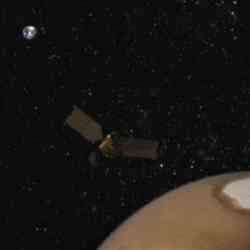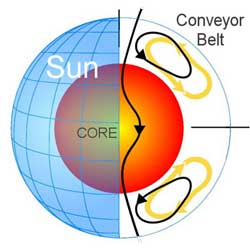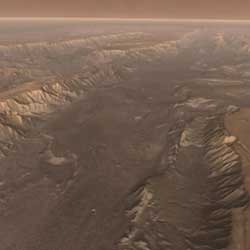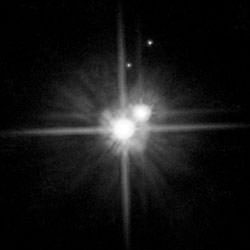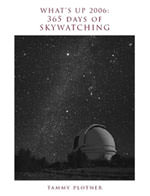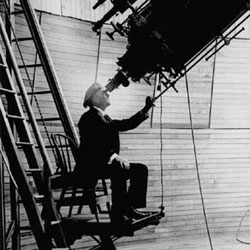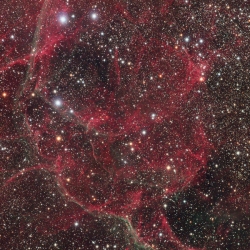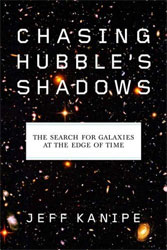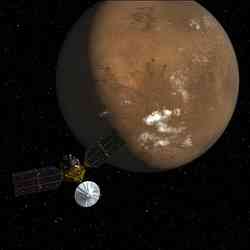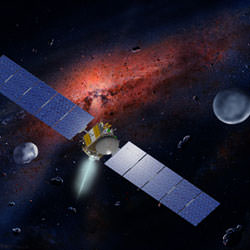
Artist illustration of the Dawn mission, now cancelled. Image credit: NASA/JPL. Click to enlarge.
With the release NASA’s 2007 budget request, it was clear that the productive science programs will be paying the price for the new Vision for Space Exploration, returning humans to the Moon and then sending them on to Mars. Many programs will be affected. We review the missions, what they were supposed to accomplish, and what the cuts will bring. It’s not a pretty picture.
Scientists, space interest groups, and even members of Congress have expressed so much concern about NASA’s $16.79 billion budget request for Fiscal Year 2007 that the Associate Administrator of NASA’s Science Directorate has reportedly agreed to review the proposed cuts in science and solar system exploration programs. According to the American Association for the Advancement of Science and their magazine Science, NASA will re-evaluate the missions and programs that are under threat of being cancelled or delayed.
The outcry over the budget proposal began immediately after it was released on February 6. At first glance, the 2007 budget would be an overall increase of 3.2% over the FY06 appropriation, or a 1.5% increase when including Katrina funding in Fiscal Year 2006. But while the proposed budget will support the space shuttle and space stations programs in addition to the emerging costs of the Vision for Space Exploration, it does so while slashing the funds needed to sustain the current and anticipated programs in science and exploration.
Central to the problems of this budget is that the space shuttle program has a projected $3 – 5 billion shortfall for the planned 17 missions before the shuttle is to be retired in approximately 2010. To alleviate that shortage, NASA is planning to shift $3 billion from planetary exploration and science over the next four years to pay for the manned missions.
The Planetary Society has said that what NASA is doing is essentially transferring funds from a popular and highly productive program (science) to one that is scheduled for termination (the space shuttle).
“I am extremely uneasy about this budget,” said U.S. House Science Committee Chairman Sherwood Boehlert from New York. “This budget is bad for space science, worse for earth science, perhaps worse still for aeronautics. It basically cuts or deemphasizes every forward looking, truly futuristic program of the agency to fund operational and development programs to enable us to do what we are already doing or have done before.”
Senator Pete Domenici from New Mexico and 59 other senators have introduced a bill to authorize a 10 percent increase per year in NASA’s science budget from now through 2013.
But Louis Friedman, Executive Director of the Planetary Society doesn’t anticipate any big changes in what Congress will approve for NASA. “I think it is unlikely that NASA will get very much of an increase in budget, but I do anticipate some give and take and perhaps some restoration of science funding,” he said. “We will be trying very hard for a major restoration of funding, but it will be a difficult fight.”
The budget shows a 1.5% increase in science funding for this year, and 1% increase for each of the following two years, before inflation is taken into consideration. But even with that increase, there will actually be $2 billion less for space science and $1.5 billion less for exploration that what was previously planned, and needed, for all of the missions to continue.
Following are some of the areas that would be affected:
– Research and analysis: 15% across-the-board cuts in grants for research, ($350 to $400 million over the next five years) with some retroactive to 2006. An official at NASA Headquarters said he wasn’t aware that any notices of specific research cuts have been issued at this time.
– Astrobiology research alone will have 50% of funding slashed.
– Astronomy and astrophysics at NASA cut by 20% over 5 years
– Aeronautics: cut by 18.1%, down to $724.4 million
In a press conference, NASA Administrator Mike Griffin acknowledged that “science and exploration are each paying to help complete our pre-existing obligations to the space station and the space shuttle, and when those obligations are completed the other major pieces of our portfolio will be able to do better.” In his congressional testimony, Griffin said, “I truly wish that it could be otherwise, but there is only so much money.”
NASA has 50 science and planetary missions currently operating, which includes missions from Voyager to the all of the Earth orbiting satellites to the recently launched New Horizons mission to Pluto. There are 22 missions that are in development, and 19 being studied for development. The budget maintains all of these missions, with the exception of some delays in launches to upgrade or replace existing Earth orbiting satellites. Following are missions that, if the current budget proposal is approved, will be cancelled or delayed:
Dawn: Cancelled.
The mission: Using an ion engine, the spacecraft would have traveled to the asteroid belt to study two dissimilar asteroids to help determine the role that size and water play in planetary evolution. It also would have helped determine the origin and evolution of our solar system. According to the NASA Watch website, 98% of Dawn’s hardware is complete, with a majority of it already integrated into the spacecraft. The shutdown costs for Dawn are $10 million, while it would take $40 million to complete the spacecraft and fly the mission.
In a statement, JPL Director Dr. Charles Elachi said, “During development a number of implementation and technical challenges led to a cost increase estimate of approximately 20% (from $373.2M to $446.5M.) Even though all the technical issues could be resolved, additional funding is still needed to complete and launch the mission by the spring of 2007. Of course we are disappointed, but the current tight budget environment has led to its cancellation.”
NASA has defended the cancellation not as a budget cut, but as a management decision due to developmental problems with the project. Louis Friedman says, “Indeed, (Dawn’s) cancellation was made separate from the budget submission and is not addressed in the Fiscal Year 2007 budget proposal. But the timing of the cancellation is suspicious – made immediately after the budget hearing in which testimony was unanimous that making mission cancellations in order to beef up research an analysis funding was an acceptable allocation of priorities.”
SOFIA (Stratospheric Observatory for Infrared Astronomy): Cancelled.
The mission: An airborne observatory consisting of a 2.5 meter reflecting infrared telescope. It would facilitate in developing observational techniques, new instrumentations, and in education of young scientists and teachers. The telescope is fully installed in a 747 aircraft and is functional. The first test flights for the observatory would have been done this year. SOFIA was being conducted in cooperation with the DLR, the German Aerospace Center, and was part of NASA’s Origins Program.
Mission to Europa: Cancelled.
Friedman said that the Europa mission was not yet an approved mission, but preliminary work had started and Congress had directed NASA to do that work in anticipation of a Fiscal Year 2007 new start for this mission. Instead NASA cancelled the existing work and ignored the request for a FY ’07 new start.
Last year, the Jupiter Icy Moon Orbiter was put down, which would have used a nuclear reactor to power an ion engine to send an orbiter to 3 of Jupiter’s moons. This year future missions to Europa have been tabled, even though the National Academy of Sciences and internal NASA advisory committees have endorsed the exploration of Europa as the next highest priority solar system objective after Mars.
Terrestrial Planet Finder: Cancelled.
The proposed mission: Terrestrial Planet Finder would have consisted of two complementary observatories: a visible-light coronagraph and a formation-flying infrared interferometer. It would study extra-solar planets, from their formation and development in disks of dust and gas around newly forming stars to studying features of planets and determining suitability for containing life.
TPF was not yet an approved mission, but preliminary development work had begun. NASA cancelled that work and removed TPF from the list of missions to be started in the next four years.
SIM Planet Quest: Delayed.
Formerly called the Space Interferometry Mission. As an optical interferometer in an Earth-trailing orbit, the spacecraft would survey approximately 100 of our closest stars and identify potential habitable planets. It would also survey thousands of other stars to help our general understanding of the formation and evolution of planetary systems. Also would help to answer questions in astrophysics concerning dark matter, black holes and the mass of the universe.
Mars Sample Return Mission: Delayed Indefinitely.
Not yet an approved mission, but preliminary development had begun. An exciting if not controversial mission to bring Martian soil to Earth.
Additional Programs Affected
Two Mars Scout missions planned for after 2011 were removed from the four year planning budget. These missions may have included airborne vehicles such as airplanes or balloons and small landers.
The Explorer Program, which launches small spacecraft to study areas such as Heliophysics and Astrophysics would be cut drastically with the earliest launch coming in 2014.
Beyond Einstein would be delayed indefinitely. These are missions such as Constellation -X and LISA that would attempt to answer questions about the Big Bang, Black Holes and Dark Matter.
The Associated Press has reported that a long list of satellites orbiting Earth are under threat of being delayed, downsized or cancelled. Scientists have warned that decreasing funding for these satellites will jeopardize the capability for forecasting weather and monitoring environmental issues.
The list includes:
Landsat: delay in launch of satellite to replace and upgrade Landsat 7, launched in 1999.
Earth Observing System: If cut, satellites such as Aqua (2002) and Terra (1999) would not be replaced when they fail.
Global Precipitation Measuring Mission: The launch of GPMM has been pushed back to 2012. GPMM will replace and upgrade the Tropical Rainfall Measuring Mission, which was supposed to be decommissioned in 2004.
Deep Space Climate Observatory: cancelled. An Earth observing satellite placed at the L-1 Point to determine cloud and radiation properties of the atmosphere. The spacecraft is already built, but would cost $60-100 million to launch and operate.
National Polar-Orbiting Operational Environmental Satellite System: Under review. Will monitor global environmental conditions, and collect and disseminate data related to weather, atmosphere, oceans and land, and is a cooperative effort between NASA, NOAA, the Department of Defense and the Department of Commerce.
The next round of Congressional hearings on the budget proposal are scheduled for March 30 at the House Appropriation Subcommittee on Science, State Justice and Commerce Hearing.
Written by Nancy Atkinson
